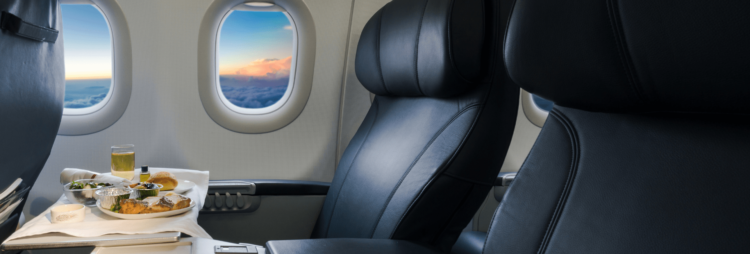![[eBook] Why OLED is an Ideal Light Source for Aerospace Applications](https://www.oledworks.com/wp-content/uploads/2021/09/Aero-eBook-Header-Clickthrough-Page-2-750x254.png)
The design of the interior cabin of commercial aircraft is a balancing act between space utilization, weight savings, safety and regulatory requirements, and passenger comfort. Lighting technology integration can play a critical role in this balance. Traditional lighting fixtures provide uneven, high-glare illumination that causes uncomfortable eye strain, while their bulky profile adds unnecessary weight and monopolizes precious cabin space. Integrating OLED lighting can address many of these challenges.
Save Space
The uniform illumination of OLED lighting technology means that no additional optical elements such as lenses or diffusers are required, keeping fixtures simple and low-profile. Panels are ultra-thin (less than 2mm), highly efficient, and have long lifetimes. The compact nature of OLED lighting, combined with the diffuse illumination from the panel, gives designers flexibility for integration on horizontal and vertical surfaces and in compact spaces, providing more design freedom to optimize cabin lighting for passenger and crew comfort.
Reduce Weight
Inorganic LED lighting requires more components than OLEDs to diffuse the light and mitigate the high levels of heat generated by the diodes. LEDs also require many serialized circuit boards to operate overhead lighting in planes, which take up more space and add more weight. OLED lighting has the potential to reduce lighting system weight by up to 50% compared to comparable LEDs. Considering commercial flights generate 2.4% of total global CO2 emissions, every gram of weight saved is crucial to airlines’ sustainability efforts.
Communicate Through Light
Communication within the cabin can be critical during loading and unloading or in emergencies. With OLED lighting technology, high-contrast segmentation allows for dynamic communication with passengers or crew for improved safety. Additionally, high-contrast segmentation expands branding potential using illuminated airline logos or personalized first-class lighting experiences. The ability to animate and reconfigure information within the same panel offers new opportunities when designing with OLED lighting.
Improve Passenger Comfort
The uniform, diffuse nature of OLED lighting makes them comfortable to be around, even when placed close to the user. OLEDs also lack UV wavelengths, meaning they pose no risk of damage to a passenger’s skin or eyes. As an added benefit, the illumination from OLED lighting is also low in the spectral content shown to interfere with melatonin production, which is ideal for helping passengers get the rest they need and adjust to their new destination’s time zones.
OLED Applications in Commercial Airlines
Because of the functionality and form factor of OLED lighting, some of the most ideal applications for OLED lighting within the cabin of a plane are:
- Overhead and Floor lighting
- Directional lighting
- Signage – Restroom, Exit, No-Smoking
- Passenger Service Units (PSU)
- Galleys, lavatories, and anywhere space is limited
To learn more about OLED lighting technology, download our eBook: Why OLED is an Ideal Light Source for Aerospace Applications.



